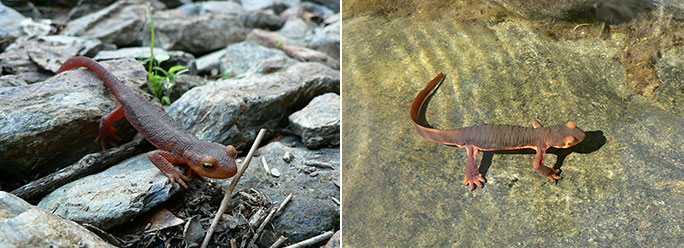Throughout most of the year, these newts are terrestrial, with thick warty skin and live underground or in damp places under rocks and logs. While in the pools, the newt's body changes into an aquatic phase, which results in smoother skin and a fin-like tail to assist with swimming. The males also develop rough pads on their feet. Why is this necessary? Well, the males have been patrolling the pools for weeks by the time the females show up and are eager to claim each as their own. The rough pads will enable them to grip the females better. Wiggling balls of wrestling newts can be seen as each female is surrounded by many males trying to get into position. After a male successfully grasps a female and swims away with her, he will deposit a spermatophore, which she carries to a suitable spot to fertilize and lay her eggs. Each spherical egg mass contains between 7 and 30 eggs and is attached to submerged vegetation or other underwater objects.
All this activity seems like it would draw a lot of attention, but the newts have an evolutionary trick that keeps them safe from predators. The bright orange color underneath is a signal that they are poisonous! Their skin contains glands that produce a potent neurotoxin, tetrodotoxin, which causes seizures that paralyze the heart and lungs. When the newt feels threatened, it will arch its back showing the bright color underneath its chin and tail. This signal deters many predators. Garter snakes (Genus Thamnophis), however, eat plenty of newts. They have preyed upon newts for so long; they have evolved a resistance to the toxin. This is a great example of coevolution between predator and prey, the newts and the garter snakes. Humans are sensitive to this toxin, which can be absorbed through mucus membranes and open cuts, so please do not handle newts.
A video of the action, including a female laying eggs is available on YouTube.

